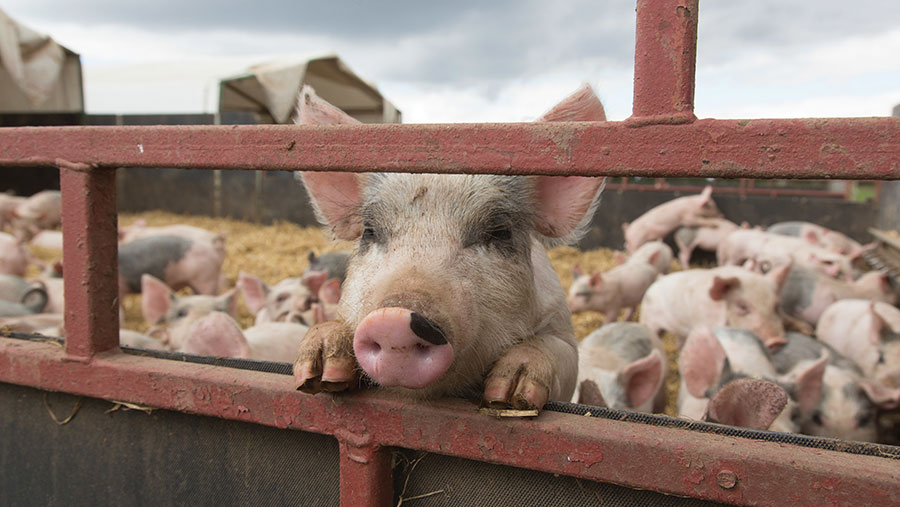How strict pig biosecurity can help to hit antibiotics targets
 © Tim Scrivener
© Tim Scrivener UK pig farmers are being urged to pay increased attention to biosecurity after a rise in swine dysentery cases last year slowed the reduction in antibiotics use.
The Responsible Use of Medicines in Agriculture Alliance (Ruma) set a target antibiotics use of 99mg/PCU to be achieved by December 2020.
Although the industry has made significant strides in reducing antibiotics use from the 2015 baseline of 263.5mg/PCU to 110mg/PCU in 2019, it has yet to meet its target for this year.
See also: Symptoms of swine dysentery
However, AHDB’s acting head of animal health and welfare, Mandy Nevel, says she is hopeful the industry will be able to meet its target by the end of the year.
She said: ““The holding pattern we are seeing at the moment is almost certainly due to a spike of swine dysentery cases in 2019.
“Swine dysentery is a bacterial disease and, while there are a number of actions that can prevent disease spread, treatment with antibiotics is sometimes both responsible and necessary to safeguard animal health and welfare.
“It is disappointing this may have prevented further reduction in our antibiotics use last year.
“However, it is right that we put animal health and welfare first and took the responsible approach and treated animals where necessary.”
Dr Nevel says farmers cannot afford to take their “foot off the pedal”.
“Every producer needs to be paying attention to internal and external biosecurity.
“A lot of dysentery has come on to units because of breaches in biosecurity,” she said.
Antibiotics data
The antibiotics data, which is collected using the electronic medicine book (eMB), found the use of highest priority, critically important antibiotics (HP-CIAs) decreased from 0.06mg/PCU in 2018 to at 0.04mg/PCU last year.
The use of Colistin represents only 0.002mg/PCU, down from 0.004mg/PCU.
Ruma antibiotics reduction targets v actual antibiotics use |
|||
|
Year |
Reduction target (%) |
Target |
Actual antibiotics use |
|
Year 1 (2016) |
35% |
171mg/PCU |
183 mg/PCU |
|
Year 2 (2017) |
25% |
128mg/PCU |
131 mg/PCU |
|
Year 3 (2018) |
10% |
115.5mg/PCU |
110mg/PCU |
|
Year 4 (2019) |
10% |
104mg/PCU |
110mg/PCU |
|
Year 5 (2020) |
5% |
99mg/PCU |
|
|
Baseline (2015) – 263.5mg/PCU |
|||
Dr Nevel added: “Despite three years of significant reductions, we will not be complacent about progress.
“The industry will continue to do everything we can to improve the health of pigs and minimise the need to administer antibiotics treatments.”
Dr Nevel said it was possible there may be a spike in antibiotics use as producers begin to move away using zinc oxide.
“We are working together as an industry and are taking a collaborative approach to make sure we don’t get a blip,” she said.
20 swine dysentery biosecurity tips
- If swine dysentery is identified, inform others that could be involved in spreading the disease
- Keep visitors to a minimum
- Use a single entry point
- Foot dip and brush at entry points and change disinfectant at least twice a week or more if it becomes contaminated
- If visitors are coming on site, provide clean boots and overalls. Disinfect any equipment they bring
- Wash wheels at the site perimeter
- Have a dead pig collection at the perimeter of the unit with foot dip and brush
- Ensure your dead stock container is leak-proof
- Keep yard clean of muck, especially where feed lorries must go
- Consider investing in a loading bay at the perimeter of the unit
- Monitor and control rodents in pig pens, feed stores, staff areas etc
- Make pig buildings bird- and insect-proof
- Keep pets off the farm to prevent indirect spread
- Do not visit other pig farms
- When moving or spreading muck, avoid spillages – do not overfill trailer and clear up any spillages that occur
- Do not share staff, tools or equipment with other farms
- Keep your yard and access to roads/passages clear of muck
- Ensure suitable drainage of dirty water and muck heap effluent
- Do not spread pig waste near your unit or other pig units
- Clean and disinfect vehicles and equipment taken off the unit
(Source: AHDB)

